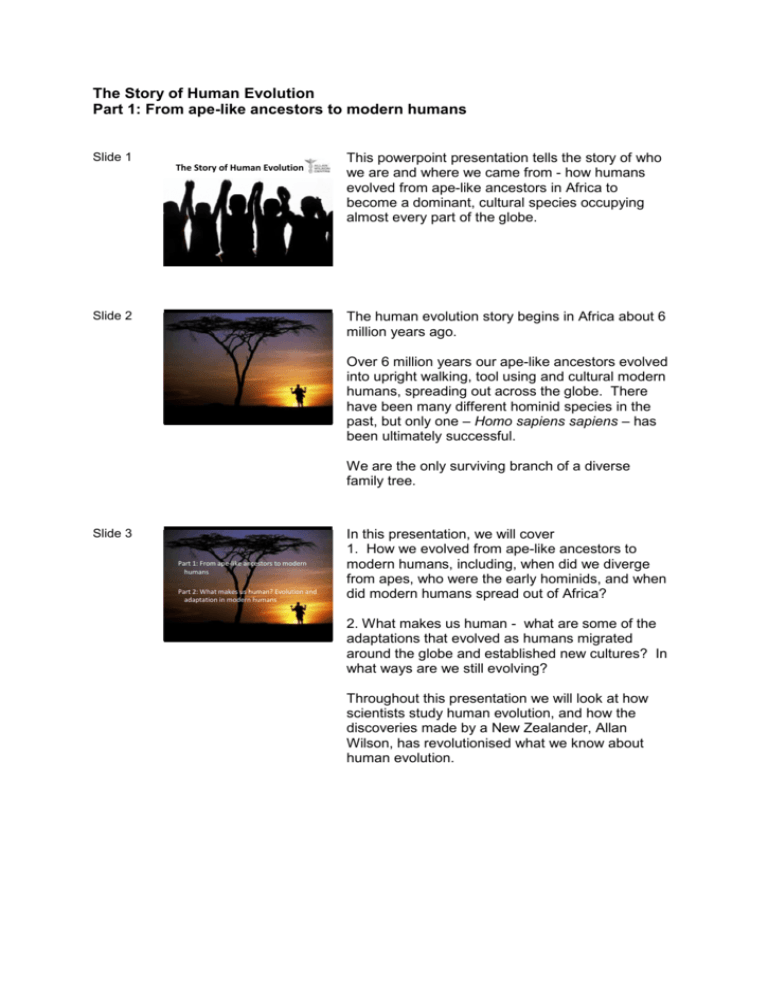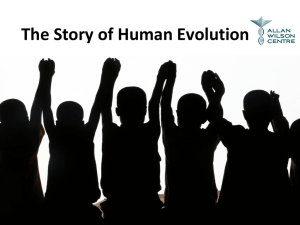Human evolution ppt1 notes
advertisement

The Story of Human Evolution Part 1: From ape-like ancestors to modern humans Slide 1 The Story of Human Evolution Slide 2 This powerpoint presentation tells the story of who we are and where we came from - how humans evolved from ape-like ancestors in Africa to become a dominant, cultural species occupying almost every part of the globe. The human evolution story begins in Africa about 6 million years ago. Over 6 million years our ape-like ancestors evolved into upright walking, tool using and cultural modern humans, spreading out across the globe. There have been many different hominid species in the past, but only one – Homo sapiens sapiens – has been ultimately successful. We are the only surviving branch of a diverse family tree. Slide 3 Part 1: From ape-like ancestors to modern humans Part 2: What makes us human? Evolution and adaptation in modern humans In this presentation, we will cover 1. How we evolved from ape-like ancestors to modern humans, including, when did we diverge from apes, who were the early hominids, and when did modern humans spread out of Africa? 2. What makes us human - what are some of the adaptations that evolved as humans migrated around the globe and established new cultures? In what ways are we still evolving? Throughout this presentation we will look at how scientists study human evolution, and how the discoveries made by a New Zealander, Allan Wilson, has revolutionised what we know about human evolution. Slide 4 Slide 5 In 1871 Charles Darwin proposed in his book “The Descent of Man” that humans evolved in Africa and shared a common ancestor with great apes. This showed remarkable foresight as at that time there were no early human fossils and no DNA evidence. How do scientists study human evolution? Humans evolved from ape-like creatures apeTHEORY Humans and apes share many Observation biological features Humans and apes HYPOTHESIS have a common ancestor 1. Measure Gather DNA evidence, differences between test with humans and apes. experiments 2. Examine fossils from several million years ago. 2. should 1. There Humans and be apes fossils with human should share a high Prediction and ape-likeof features percentage DNA Since Charles Darwin’s time, scientists have gathered a huge amount of evidence about human evolution. Using the scientific method they form and test ideas to build theories about human evolution. Ideas generally start with an observation, from which scientists form a hypothesis. A hypothesis is a testable statement about the world based on observations. From a hypothesis we can make a prediction about what would happen in the hypothesis was true or false, and scientist then gather evidence to test whether their hypothesis is true. If the hypothesis is supported by multiple lines of evidence, it becomes a theory. In science a theory doesn’t mean a guess or a hunch. It means a well-supported explanation for some aspect of the natural world that incorporates facts, laws, observations and testable hypotheses. In the case of human evolution, Charles Darwin noted that humans and apes share many biological features (click 1). He hypothesized that (click 2) humans and apes share a common ancestor. If this hypothesis is true then (click 3) humans and apes should share a high percentage of their DNA, and (click 4) there should be fossils with humans and ape-like features. Darwin wasn’t able to gather this sort of evidence to test his hypothesis in his time, but many studies since then have tested these predictions (click 5). Both DNA and fossil evidence support the hypothesis of humans and apes sharing a common ancestor, and the idea that humans evolved from ape-like creatures is now an accepted theory. Slide 6 Old-World monkeys Gibbon Orangutan Gorilla Chimpanzee Human Slide 7 0 Monkey Chimp We now know, from genetic and fossil evidence, that our closest relative is the chimpanzee. This does not mean we evolved from chimpanzees, it means that we share a common ancestor. Until the 1960s it was thought that the earliest humans split from their ape-like ancestors at least 20 million years ago. Allan Wilson’s work changed all that. In 1967 he showed that apes and humans are much more closely related– diverging only 5-6 million years ago. Human 10 20 30 Time (million yrs ago) Allan Wilson 1934 - 1991 Allan Wilson was born in Ngaruawhia and studied at Otago University. He left New Zealand to study at the University of California, Berkeley and remained there until his death in 1991. Allan Wilson was one of the first people to use genetics to study how species are related to one another. Slide 8 The structure of DNA was discovered 1953 . The instructions written in the DNA code for proteins. DNA and proteins can be used to study genetic similarities between species Before the 1970s the technology to sequence DNA directly wasn’t developed. However, researchers were able to analyse the proteins produced from DNA, so they used proteins to study the genetic similarities between species. If two species are closely related, they should have similar DNA sequences, which should then make similar proteins. Slide 9 Molecular differences show that humans diverged from chimpanzees 5-6 million years ago 0 Monkey Chimp Human 10 Allan Wilson took advantage of the fact that DNA and therefore proteins change at a known rate over time. Because of this, DNA (and proteins that are produced from DNA) can act as a molecular clock. 20 30 Time (million yrs ago) Allan Wilson 1934 - 1991 By measuring the number of changes in DNA or proteins between two different species, we can calculate how long it has been since those species shared a common ancestor. Monkey Chimp Human 20 30 Human – monkey difference Time (million yrs ago) 0 10 20 30 Albumin protein Sequence difference 0 10 Monkey Human – chimp difference Chimp Human Sequence difference Slide 10 If humans diverged from apes and monkeys many millions of years ago as was originally thought, then there should be a large number of differences between the DNA and protein sequences of humans and apes (almost as many as the number of differences between humans and monkeys). Allan Wilson and his collaborator Vince Sarich compared the blood proteins of humans and chimpanzees and found that they were extremely similar – much more similar than the proteins of monkeys . By counting the number of changes between humans and chimpanzees, he calculated that they shared a common ancestor around 5 million years ago. This finding caused a sensation when it was first published in 1967, and was not accepted by many anthropologists for some time. However, many subsequent studies using different genes as the “clock” gave the same result, and the divergence time of 5-6 million years is now well accepted. Slide 11 Our earliest ancestors lived in Africa The genetic results were also supported by evidence from fossils. The earliest human-like fossils have been found in Africa and date back to 4-8 million years ago. They show that our earliest ancestors walked upright, but had much smaller brains and did not yet use sophisticated tools or use fire. Slide 12 Many different human-like species existed over the 4-8 million years since our lineage split from apes – collectively, we call these species hominids. Some of these species would have lived at the same time, and not all of them are the direct ancestors of modern humans. We don’t know the exact progression from species to species that led to modern humans. There are many different ideas, and as new fossils are discovered the gaps become filled and the picture becomes clearer. Slide 13 Lucy is one of the most important hominid fossils ever discovered Hadar, Ethiopia – site of Lucy’s discovery One of the most important hominid fossils ever discovered is that of “Lucy”. Lucy was discovered by Donald Johansson in Hadar, Ethiopia. This area is rich in fossils, but it wasn’t until Johansson’s third trip to Hadar that he found Lucy. She was discovered near the end of the field season in 1974 – Johansson was about to leave his field site when the fossil caught his eye. He soon realised that it was a partial hominid skeleton eroding from the ancient sediment. As the team examined the fossil that night, the song “Lucy in the sky with diamonds” was playing, so they named the fossil Lucy. Slide 14 At the time of her discovery, Lucy was one of the oldest and most complete hominid fossils ever found. Slide 15 Lucy belongs to the species Australopithecus afarensis, and lived 3.2 million years ago. She stood around 1.1 metres (3.5 feet) tall and she walked upright on two legs, although she probably had a less graceful gait than us, since she walked with her legs bent. Australopithecus - an ape who walked on two legs This discovery confirmed that bipedalism evolved very early in our evolutionary history. Slide 16 Footprints left by Australopithecus confirm early upright walking A few years later a set of footprints were discovered in hardened ash in Tanzania. These footprints date to 3-4 million years ago and were probably also made by Australopithecines. The creature that made these footprints undoubtedly walked upright further confirming that our ancestors were bipedal several million years ago. More recently discovered fossils dating back 5-6 million years also show signs of being bipedal. The shift to bipedalism was a highly significant event in our history as it freed the hands to use tools. Slide 17 The earliest stone tools are from 2.3-2.5 million years ago It is not just fossil bones and footprints that can tell us about our evolutionary history – scientists also look for evidence of the things our ancestors used and ate in order to understand how we evolved. The first stone tools appear in the fossil record 2.32.5 million years ago. These are associated with Homo habilis fossils. Slide 18 Homo habilis was the first to use stone tools Slide 19 Homo habilis was more recognisably human than the Australopithecines – he had a smaller jaw, larger brain and ate meat. Eating meat may have driven development of larger brains. In later fossil sites, researchers have discovered more sophisticated stone tools, and evidence for the controlled use of fire. Early humans were using fire and sophisticated tools 1.8 million years ago. Slide 20 Homo erectus was the first to migrate out of Africa This development may have allowed early humans to move out of Africa for the first time, probably from about 1.8 million years ago onwards. These individuals were member of the species Homo erectus - fossils from this species have been discovered in Europe and Asia. With this species distinctly “human” traits became more developed. They were larger and built more like modern humans and had larger brains than earlier species. Slide 21 When and where did modern humans evolve? str Au pit alo s cu he o m Ho is bil ha o m Ho tus ec er sis ns o m len pie sa Ho rtha o m de an Ho e n Slide 22 Modern humans Europe Africa Asia Africa Slide 23 Modern humans Africa By 170,000 years ago there were hominids living in Europe, Africa and Asia. So where and when did modern humans evolve? Did we evolve from Homo erectus separately in Asia, Africa and Europe? We know Homo erectus migrated out of Africa about 1.8 million years ago, and hominid populations were living in Europe and Asia. This hypothesis suggests that modern human populations evolved from these ancient populations separately in Asia, Africa, and Europe, but with some interbreeding along the way. Homo erectus Europe The earliest anatomically modern Homo sapiens fossils date to only 170,000 years ago. If you look through the fossil record, the average lifespan of a mammal species is 10 million years, so Homo sapiens is a comparatively young species. Asia Or did we evolve in Africa and migrate out recently (within the last 100,000 years), replacing existing hominid populations? Until the 1980s the first hypothesis was favoured – modern humans evolved from Homo erectus separately in Asia, Africa and Europe. But Rebecca Cann and Allan Wilson showed that modern humans originated in Africa, evolving relatively recently from a small ancestral population. This supports the second hypothesis which is referred to as the “Out of Africa” hypothesis. Homo erectus Africa Cann and Wilson showed that we can all trace our DNA back to one woman who lived in Africa around 200,000 years ago. Slide 24 Nucleus Mitochondria Allan Wilson and Rebecca Cann used mitochondrial DNA to make this discovery. Mitochondria are cellular structures that convert food into energy that the cell can use. Mitochondria have their own DNA, which is totally separate from the DNA found in the nucleus (where the chromosomes are). Slide 25 Mitochondria are only found in eggs and not in the head of a sperm, so we only get mitochondrial DNA from our mothers. Mitochondria: DNA comes from mother Nucleus: DNA comes from both parents Offspring cell Slide 26 Mitochondrial DNA traces the female line Because mitochondrial DNA is only passed down from female to female and doesn’t get mixed with DNA from the father, changes in mitochondrial DNA over time can be easily traced back Imagine these dots represent a population in Africa living 200,000 years ago - each one of the dots a female person. Some mitochondrial types get passed down to the next generation (click 1). Occasionally there is a mutation, or spelling mistake in the DNA (click 2). Usually this is not harmful, so it gets passed down to the next generation (click 3). Some mitochondrial lineages die out over time (click 4), and gradually one lineage will replace all the others (clicks 5-9). The spelling mistakes in the DNA happen at a fairly constant rate over time, so by counting the number of changes in the DNA between two different people we can work out how much time has passed since those people shared a common ancestor. The more DNA differences between two people, the less closely related they are likely to be. Allan Wilson and Rebecca Cann studied mitochondrial DNA sequences of people from around the world, and found that they could all be traced back to one common mitochondrial sequence that existed in Africa about 200,000 years ago. This means that all humans alive today are ultimately descended from one common female ancestor, who we call “Mitochondrial Eve”. Mitochondrial Eve was not the only women alive 200,000 years ago – she was part of a population that would have contained many other women with other mitochondrial DNA sequences. However, over time these other lineages died out one by one, and by chance one lineage replaces all the others. Slide 27 Slide 28 We are all descended from a small population living in Africa 150,000 to 200,000 years ago Modern humans colonize the globe 4500 15,000 25,000 40,000 12,000 100,000 70,000 3000 200,000 1500 50,000 Homo sapiens Neanderthals Early hominids So, it is now well accepted that all humans alive today are descended from a small population who lived in Africa 150,000 to 200,000 years ago. Modern humans began to migrate out of Africa around 100,000 years ago. This map shows the migration paths (in red) that modern humans took, and where the hominid species descended from Homo erectus that migrated out many thousands of years earlier were living. 800 As humans moved through Europe and Asia they would have met these earlier hominids, like the Neanderthals in Europe. They largely outcompeted and replaced these older species, but there is some evidence that they interbred. Along the way, human culture as we know it developed – art, clothing, jewellery, music and ceremonies such as burials.







